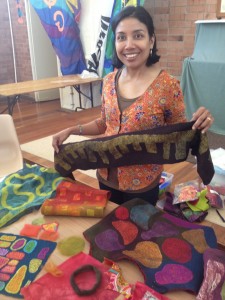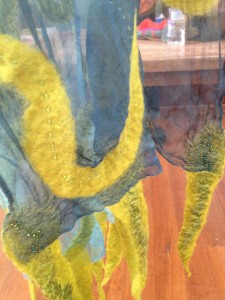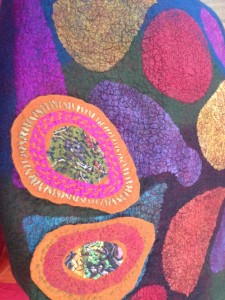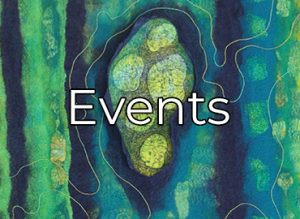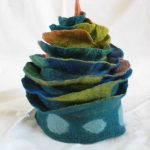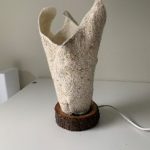
Nuno Scarves – A Focus on Design – Workshop Review
by Virginia Campbell
Many members will be familiar with the very fine, skilfully designed, beautifully coloured and exquisitely draping nuno felted scarves and wraps of fellow FeltWest member, Alison Gomes. So it was with great delight that 12 of us anticipated her workshop at Craft House on 2 May to learn how to improve our nuno felting technique and design while experimenting with different ways of creating nuno felt.
Alison began the workshop by reminding us of some basic key principles of felting including the importance of choosing the correct wool for the project and avoiding the mixing of different types of wool fibre to achieve a more even finish, and laying an even number of fine wool layers in both directions (rather than fewer thick layers of wool) to improve the finished piece’s drape ability, and to achieve even shrinkage, finer texture and better overall strength. She demonstrated how she lays wool finely and discussed the number of layers of wool she had laid in various sample pieces. She discussed factors affecting shrinkage (the less wool used the greater the shrinkage will be, and shrinkage will be in the direction the fibres are laid and also in the direction in which it is rolled) , how to avoid creases (don’t roll the piece too tightly, lift your noodle when rolling up a piece) and how to avoid distortion occurring when fulling ( regularly checking your piece, spreading it open, stretching it into shape with your palms, not finger tips). She spoke of gently rinsing the felted piece in several changes of tepid then cooler water to remove all residue of soap, gently squeezing the excess water out, laying the piece flat and when it is still slightly damp, ironing it on the reverse side (lifting the iron to press the piece, rather than dragging the iron across the work) to give a beautiful flat finish.
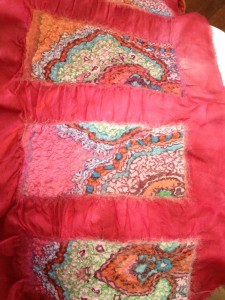
She then discussed choosing fabrics to use in nuno felting – preferably those which are lightweight, open weave and made of natural fibres like open weave silks, chiffon, organza, georgette, silk velvet, rayon, cotton voile, viscose, muslin. Alison recommended that before using a fabric for the first time you should always checking the fabric is colourfast and iron it, especially if you intend cutting shapes from it.
Alison discussed 6 different ways of creating nuno felt:
1. Using a fabric base with a wool design (wool roving or wool pre felt cut into shapes) arranged over it,
2. Laying a wool base with fabric motifs placed on it,
3. Creating a wool design laminated between two layers of fabric,
4. Entrapping non- feltable objects between wool and fabric layers, thereby creating texture or shapes,
5. Using wool and fabric in the one layer
6. Creating nuno pre felts, cutting out those pre felts and placing them on a fabric base
She illustrated these techniques with numerous examples of her work which she passed around together with various fabric pieces she had used. We were able to see and feel the textures which had been achieved using these techniques and different fabric examples.
Alison mentioned a number of helpful tips including lining any fabric motifs to be placed on a wool or fabric base with appropriate coloured wool to “intensify” the colour of the fabric motifs, cutting fabric motifs larger than the size ultimately desired to allow for their shrinkage in the felting process, and using nuno pre felts and hand laid roving pre felts or machine needled pre felts to achieve precise shapes, (but note with cut pre felt shapes there will be some feathering of the cut ends of the wool onto the background).
Alison then discussed a number of design principles we can apply to our work to help create beautiful harmonious designs, encouraging us to consider concepts of balance, repetition, movement, scale, use of negative space and possible themes such as floral, geometric, abstract, when designing a piece. She recommended sketching a design at the outset before embarking on laying out your piece to help clarify the materials you will use and the design principles you will apply. She also discussed colour as a powerful design tool and the effects which can be achieved through the use of different colours. She brought along numerous images from a variety of magazines to illustrate diverse colour combinations and to help inspire us to be brave and to try something new – to consider moving from classic combinations of colour to experimenting with unusual pairing of hues to bring originality and freshness to a design.
Then we were off to work – creating samples of the various techniques we had observed, using colour in more adventurous ways than we might have initially envisaged, and some of us launched into designing some bigger pieces incorporating a number of different nuno felting techniques and colour combinations.
Throughout the remainder of the workshop Alison visited with us all individually, suggesting, advising, encouraging, assisting, consulting, inspiring. We all very much appreciated Alison’s clear explanations and instruction throughout the workshop , her thoughtful provision of a large quantity of diverse, illustrative materials and her individual assistance with our developing nuno felting projects in the afternoon. She also generously provided us all with comprehensive notes of the morning’s instruction session which we were able to take home for later reference if needed. It was a wonderful workshop with plenty of sharing, learning, fun and new friendships. We’re all looking forward to the next Toss n Tell to see more of the results of the day.
